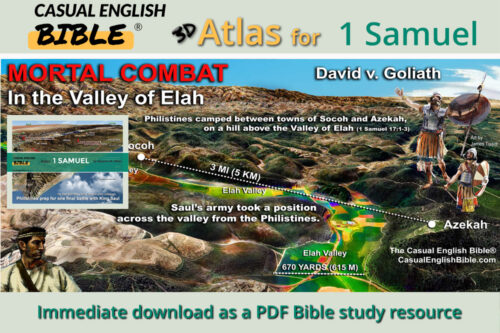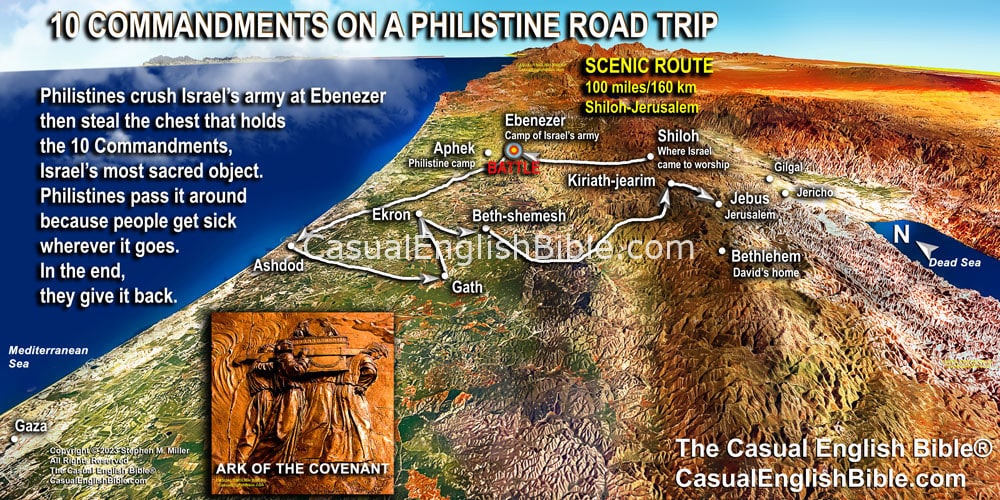1 Samuel 6
Philistines return Israel’s Ten Commandments
Philistines want to get rid of the Box of the Law
1The Box of the Law stayed on Philistine land for seven months. 2Philistines went to their priests and fortunetellers and asked, “What’s it going to take to get rid of this Box of the LORD?”3They said, “Whatever you do, don’t send the box home alone. Send it with offerings to buy forgiveness—so we can erase our guilt and get rid of this sickness.”
4The people said, “What kind of guilt offering would work?” The spiritual leaders said, “Make images of five gold bumps and five gold mice. They’ll represent gifts from the Philistine rulers in all five of our cities. This plague struck all of us, and the rulers.
How to return the Box of the Law
5Make golden bumps and mice. They’ll symbolize what has devastated our nation. This will also show that you respect the power of Israel’s God. Afterward, he may decide to show some mercy to us, our land, and our gods.6What’s the value of getting defensive and stubborn about this, the way the Egyptians did when Pharoah refused to release the Hebrews? He made himself and his nation look like fools. And in the end, he gave in, and he freed them.
7Get a new cart to carry the Box of God and your offerings. Find two cows to pull it. Not just any cows, but cows that have never worn a yoke for pulling things. [1] They must have young calves. But you’ll need to take the calves back to their pens, out of sight of the cows. [2]
8Put the Box of the LORD on the cart. Put your gold figures in a separate box beside it. This box of gold is your gift to pay for your guilt to be forgiven and erased.
9Send the cows and the cart on their way and watch where they go. If the cows start pulling the cart toward Beth-shemesh, [3] in Israel’s territory, that will be your sign God is behind what happened to us. But if they go in another direction, we’ll know that this happened by chance, and it was just one of those things.
Israel’s holy box in a cow cart
10Philistine men did it. They found two cows that had recently delivered calves. They yoked them to the cart and separated them from the calves. 11They loaded the Box of the LORD onto the cart along with the box of god mice and images of bumps.12The cows followed the path toward Beth-shemesh, mooing [4] along the way. They didn’t veer off the trail. Philistine rulers followed them all the way to the city limits of Beth-shemesh.
Israel’s farmers find the Box
13People in Beth-shemesh were busy harvesting their valley wheat crop. [5] But when they looked and saw the Box of the Law on a cart, they ran cheering to get it.14The cart came to a place in Beth-shemesh called Joshua’s Field. There was a large rock in the field, and the people decided to use it as an impromptu altar. They chopped up the cart for firewood. And they slaughtered the cow as a burnt offering [6] sacrifice for sin.
15Levites [7] were there, associates of Israel’s priests. They had lifted from the cart the Box of the Law and the box of gold offerings, and they set them on the large rock. Then the citizens of Beth-shemesh sacrificed the cows to the LORD. 16The five Philistine rulers watched from a distance, then returned to Ekron. [8]
17The five gold figures of bumps represented guilt offering [9] gifts to the LORD, on behalf of the five Philistine cities: Ashdod, Gaza, Ashkelon, Gath, and Ekron. 18The gold mice represented all the Philistine cities controlled by the five rulers. Some cities were protected behind walls. Some were open villages. The large stone in Joshua’s Field serves as a reminder of what happened to the Philistines. [10]
70 men look in Box and die
19But some men of Beth-shemesh got too curious. They looked inside the Box of the Law. God killed 70 [11] of them. The people mourned for them because this was a tragic and heartbreaking loss for the city. 20Worried citizens of Beth-shemesh asked, “Is anyone here holy enough to handle sacred objects of the LORD, a holy God? Who can help us send this wherever it needs to go?”21They sent messengers up to Kiriath-jearim. [12] asking, “Would you come down and take custody of the Box of the LORD? The Philistines brought it back to us.”
Footnotes
Some Jewish sacrifices involved cattle that had never worn a yoke. Jews used the ashes of a red heifer for cleansing rituals, and it never wore a yoke. Cattle that had never done secular work, were apparently considered an appropriate gift. It was reserved for God’s work.
Cows with calves tend to follow their calves or try to find them if out of sight. If the Philistines hitched the cows to the cart a good distance away from the calves, perhaps the cows would go hunting for them—and wander out of Philistine territory. That may have been the plan.
Beth-shemesh was a city about 12 miles (20) southeast of Ekron. The Philistine city of Ekron was the last reported location of the Box of the Law, known also as the Ark of the Covenant. That distance is perhaps a half-day walk for a human. Who knows how long for a cow pulling a cart without a driver? The Israelite city was also 15 miles (24 km) west of Jerusalem, less than a day’s walk.
It’s hard to know what a “moo” means. But people who work with cattle say they seem to moo for many reasons. Sometimes they seem to be warning of danger. And often they seem to call for one another. A cow for a calf. A calf’s call for mother’s milk. A call for a hookup with a mate. And in this case, perhaps a call to get unhooked from the cart and yoke.
Farmers harvested barley in March and April, then wheat in May through July.
A “burnt offering” is one that consumes the entire animal and pays the price for sin. It atones for sin. Laws related to the burnt offering are in Leviticus 1. It was perhaps ancient Israel’s most used sacrifice.
In the broadest sense, Levites were Israelites from the tribe of Levi. They were all descendants of Jacob’s son, Levi. All priests were Levites. But there were many Levite men who didn’t qualify for the priesthood. Some were priestly associates also known as Levites. Levites within the Levites. Like New York, NY. It seems people treated these Levites as a second class of priests, with a lower rank. These were probably the Levites the writer was talking about.
We’re left to wonder if the Philistine rulers sent a messenger to the people in the wheat field to explain the cart. And perhaps they explained the Philistine desire that the Israelites treat this as a guilt offering. We don’t know that’s what happened. But we wonder how the average Israelite wheat farmer, without help, would have even recognized the sacred Box that is usually kept sequestered in the holiest room of the worship center. We also wonder to what extent the Philistine rulers may have gently herded the cows by sometimes riding alongside or ahead, though the writer says they rode behind. All the time? Or most of time? Or some of the time? All fair questions, it seems.
In older lingo, the guilt offering was called the trespass offering, as in, “Forgive us our trespasses” or sins. In fact, scholars can’t seem to figure out what the difference is between a “sin offering” and a “guilt offering.” One guess is that guilt offerings are more serious and often involve making restitution. Leviticus 5:14-7:7 talks about when a person needs to make a guilt offering. Leviticus 7:1-10 talks about how to make the sacrifice. There are differences between a guilt offering that the Philistines described and a burnt offering that the Israelites seemed to offer. Some of the meat of a guilt offering was kept, to eat. Burnt offerings were entirely burned up in the fire (Leviticus 1).
Oddly, though the Philistines wanted their guilt removed, the stone became a long reminder of their guilt.
Or was it 50,000? A few manuscripts say God killed 70. Most ancient copies of this scripture seem to make no sense because they say “70 men, 50,000 men.” In a later plague on Israel, during King David’s time, one Bible history writer said God killed 70,000 (2 Samuel 24:15). So the 50,000 count here isn’t inconsistent with David’s plague.
Kiriath-jearim was about 8 miles (13 km) northeast of Beth-shemesh and uphill more than a thousand feet—from 890 feet (272 m) to 2,000 feet (600 m).
Discussion Questions
- Sorry, there are currently no questions for this chapter.






